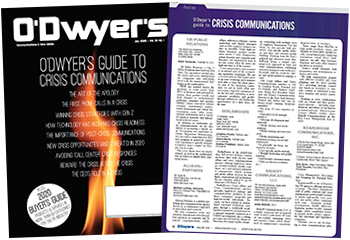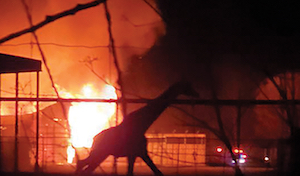 Jill Allread Jill Allread |
Rarely is a crisis expected, but how well a business responds to the unexpected will reflect either poorly or positively on future public perception of—and confidence in—the organization. One determining factor is whether or not business leadership proactively uses post-crisis communications.
Everything’s at risk of disruption when an organization is navigating a crisis. From the Board Chairman to the CEO and senior leaders to front-line employees, everyone’s attention is distracted during a crisis. If leadership is savvy, legal advisors and crisis communication counselors are employed to provide needed support. By the time a crisis appears resolved, team members are exhausted from the pressures of navigating the high-stakes issue. They’re anxious to put the crisis behind them and return to normal. Their budgets are tight because of the unexpected expenses of the crisis. But this is exactly the time more work is needed to restore and strengthen an organization’s reputation and relationship with its publics.
 |
| This article is featured in O'Dwyer's Jan. '20 Crisis Communications Magazine. |
It doesn’t matter what created the crisis: labor issues, lawsuits, cyber breaches, personnel issues such as #MeToo allegations, attack campaigns, shootings, accidents or natural disasters. Too often businesses underestimate how long residual threats last in the aftermath. Questions like: “To what degree did the crisis influence public perception of our brand? How do we regain public confidence after this crisis? Does our reputation need to be repaired or completely rebuilt?” must be addressed. Strategic communications can reach audiences to proactively answer questions and concerns and earn respect for doing the right thing.
One recent example of doing the right thing in crisis response and post-crisis recovery happened when a management team in the Midwest suffered a heartbreaking accident. The holiday-shift staff on the grounds of a popular wildlife safari park discovered a fire in one of the park’s animal barns shortly after 6:20 p.m. on Thanksgiving, when the property lost power.
Flames from the weather-related electrical fire engulfed the barn so quickly that ten animals inside—including three giraffes—perished. The team’s quick action saved several zebras housed in outdoor enclosures and, as a precaution, the team released into secure fields two other giraffes in a nearby barn that was also in danger of burning if the fire spread. One of the giraffes was photographed by a person passing by the park. The image of the fleeing giraffe in silhouette against a background of flames was widely used in national and regional news outlets. While those giraffes survived, the wildlife park staff were devastated by the loss of animals they cared for every day. They felt like they lost family members.
Notified about the fire, park owners called on Public Communications Inc. crisis counselors to provide immediate support, including crisis communication strategies to gather and share accurate and timely information as well as provide messaging for media interviews Thanksgiving night, a news release and media statements and social media content and strategy.
 Public Communications Inc. was called to provide crisis support after a fire broke out at the African Safari Wildlife Park in Port Clinton, Ohio on Thanksgiving. Images of the blaze captured by bystanders were widely shared by national news outlets. Public Communications Inc. was called to provide crisis support after a fire broke out at the African Safari Wildlife Park in Port Clinton, Ohio on Thanksgiving. Images of the blaze captured by bystanders were widely shared by national news outlets. |
Because animal-related stories generate strong public interest, news of the fire began trending on social media and regional news outlet channels within minutes. People expressed concern for the staff and sadness over the loss of the animals, particularly the charismatic giraffes. Some made comments critical of the park for having wildlife and for failing to save the animals. Communication team members effectively used messages based on honesty and empathy to respond openly to questions and comments on the park’s social channels.
Another wave of media and public interest surged the next afternoon following a news conference in collaboration with fire and police agencies. The park distributed another news release with updates about the animals lost and the wellbeing of animals saved. By the following Wednesday, fire officials determined the fire was accidental and announced the case closed; however, post-crisis communication strategies continued, driven by the goal to build strong public confidence in the wildlife park’s response to the disaster.
Strategies included providing behind-the-scenes updates on happenings at the park that was then closed for the season. These included:
- Insights into the grief counseling provided to staff saddened by the loss.
- Examples and stories of the extraordinary care of the park’s 400 animals.
- Updates on the wellbeing of the giraffe photographed the night of the blaze. Much to the relief of their fans, the park featured the rescued giraffe on its Facebook page happily receiving special snacks from his keepers.
- Plans to honor the memory of the animals lost in the fire.
Post-crisis communications helped anticipate and address questions and the public’s interest in the welfare of the animals. For example, with offers of support from people across the country, the park announced it would send all donations to an international giraffe conservation nonprofit organization working to save giraffes in Africa. Proactive communication continued to help strengthen the park’s relationship with its members, partners, social media fans and staff. The crisis-recovery plan continues being implemented with strategies for next season’s re-opening and animal stories that foster the public’s love and care for wildlife.
Here’s a quick checklist to help guide post-crisis recovery that can have a positive effect on an organization’s long reputation:
- Conduct a crisis post-mortem debrief and analysis. Include detailed analysis of the organization’s social media engagement and sentiment.
- Follow through on any promises made to the public, employees, other stakeholders and pros. Proactively communicate those actions and follow up.
- Communicate to rebuild any damaged relationships. Identify all key audiences who should know about progress being made, including customers or members, employees, shareholders and, if needed, regulatory or accrediting agencies. If nonprofit, then donors, too.
- Build confidence in leadership. A crisis can be an opportunity to showcase inspired leadership to renew an organization. A leader of good character who’s truly committed to the values of an organization can step forward with optimism to rebuild the organization to be even better than it was before the crisis.
By understanding the complexity of a crisis and employing effective post-crisis communication strategies, an organization will not only survive, it will thrive.
***
Jill Allread, APR, is CEO of Public Communications Inc., a national independent PR and digital agency headquartered in Chicago.


 There’s a fine line between newsjacking and taking advantage, aka ambulance chasing. Our job as PR professionals is to tread it carefully.
There’s a fine line between newsjacking and taking advantage, aka ambulance chasing. Our job as PR professionals is to tread it carefully. PR firms need to be mindful of ways their work product may be protected by the attorney-client privilege whenever working with a client’s internal legal team or its external legal counsel.
PR firms need to be mindful of ways their work product may be protected by the attorney-client privilege whenever working with a client’s internal legal team or its external legal counsel. Manuel Rocha, former US ambassador and intenational business advisor to LLYC, plans to plead guilty to charges that he was a secret agent for Cuba.
Manuel Rocha, former US ambassador and intenational business advisor to LLYC, plans to plead guilty to charges that he was a secret agent for Cuba. CEO mentoring is an often-overlooked aspect of why CEOs are able to make good decisions, and sometimes make bad ones—all of which intersects with the role and duties of a board.
CEO mentoring is an often-overlooked aspect of why CEOs are able to make good decisions, and sometimes make bad ones—all of which intersects with the role and duties of a board.  How organizations can anticipate, prepare and respond to crises in an increasingly complex world where a convergent landscape of global challenges, threats and risks seem to arrive at an unrelenting pace.
How organizations can anticipate, prepare and respond to crises in an increasingly complex world where a convergent landscape of global challenges, threats and risks seem to arrive at an unrelenting pace.


 Have a comment? Send it to
Have a comment? Send it to 
No comments have been submitted for this story yet.